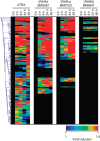Dissecting the retinoid-induced differentiation of F9 embryonal stem cells by integrative genomics
- PMID: 21988834
- PMCID: PMC3261707
- DOI: 10.1038/msb.2011.73
Dissecting the retinoid-induced differentiation of F9 embryonal stem cells by integrative genomics
Abstract
Retinoic acid (RA) triggers physiological processes by activating heterodimeric transcription factors (TFs) comprising retinoic acid receptor (RARα, β, γ) and retinoid X receptor (RXRα, β, γ). How a single signal induces highly complex temporally controlled networks that ultimately orchestrate physiological processes is unclear. Using an RA-inducible differentiation model, we defined the temporal changes in the genome-wide binding patterns of RARγ and RXRα and correlated them with transcription regulation. Unexpectedly, both receptors displayed a highly dynamic binding, with different RXRα heterodimers targeting identical loci. Comparison of RARγ and RXRα co-binding at RA-regulated genes identified putative RXRα-RARγ target genes that were validated with subtype-selective agonists. Gene-regulatory decisions during differentiation were inferred from TF-target gene information and temporal gene expression. This analysis revealed six distinct co-expression paths of which RXRα-RARγ is associated with transcription activation, while Sox2 and Egr1 were predicted to regulate repression. Finally, RXRα-RARγ regulatory networks were reconstructed through integration of functional co-citations. Our analysis provides a dynamic view of RA signalling during cell differentiation, reveals RAR heterodimer dynamics and promiscuity, and predicts decisions that diversify the RA signal into distinct gene-regulatory programs.
Conflict of interest statement
The authors declare that they have no conflict of interest.
Figures






Similar articles
-
Retinoid regulated association of transcriptional co-regulators and the polycomb group protein SUZ12 with the retinoic acid response elements of Hoxa1, RARbeta(2), and Cyp26A1 in F9 embryonal carcinoma cells.J Mol Biol. 2007 Sep 14;372(2):298-316. doi: 10.1016/j.jmb.2007.06.079. Epub 2007 Jul 3. J Mol Biol. 2007. PMID: 17663992 Free PMC article.
-
Gene expression profiling elucidates a specific role for RARgamma in the retinoic acid-induced differentiation of F9 teratocarcinoma stem cells.Biochem Pharmacol. 2008 Mar 1;75(5):1129-60. doi: 10.1016/j.bcp.2007.11.006. Epub 2007 Nov 22. Biochem Pharmacol. 2008. PMID: 18164278 Free PMC article.
-
Specific retinoid receptors cooperate to signal growth suppression and maturation of human embryonal carcinoma cells.Oncogene. 1998 Jul 2;16(26):3471-80. doi: 10.1038/sj.onc.1201876. Oncogene. 1998. PMID: 9692555
-
F9 embryocarcinoma cells: a cell autonomous model to study the functional selectivity of RARs and RXRs in retinoid signaling.Histol Histopathol. 2001 Jul;16(3):909-22. doi: 10.14670/HH-16.909. Histol Histopathol. 2001. PMID: 11510982 Review.
-
Retinoic Acid-Regulated Target Genes During Development: Integrative Genomics Analysis.Subcell Biochem. 2020;95:57-85. doi: 10.1007/978-3-030-42282-0_3. Subcell Biochem. 2020. PMID: 32297296 Review.
Cited by
-
The elongation complex components BRD4 and MLLT3/AF9 are transcriptional coactivators of nuclear retinoid receptors.PLoS One. 2013 Jun 10;8(6):e64880. doi: 10.1371/journal.pone.0064880. Print 2013. PLoS One. 2013. PMID: 23762261 Free PMC article.
-
The ancestral retinoic acid receptor was a low-affinity sensor triggering neuronal differentiation.Sci Adv. 2018 Feb 21;4(2):eaao1261. doi: 10.1126/sciadv.aao1261. eCollection 2018 Feb. Sci Adv. 2018. PMID: 29492455 Free PMC article.
-
Epimetheus - a multi-profile normalizer for epigenomic sequencing data.BMC Bioinformatics. 2017 May 12;18(1):259. doi: 10.1186/s12859-017-1655-3. BMC Bioinformatics. 2017. PMID: 28499349 Free PMC article.
-
Reconstructed cell fate-regulatory programs in stem cells reveal hierarchies and key factors of neurogenesis.Genome Res. 2016 Nov;26(11):1505-1519. doi: 10.1101/gr.208926.116. Epub 2016 Sep 20. Genome Res. 2016. PMID: 27650846 Free PMC article.
-
Polycomb recruitment attenuates retinoic acid-induced transcription of the bivalent NR2F1 gene.Nucleic Acids Res. 2013 Jul;41(13):6430-43. doi: 10.1093/nar/gkt367. Epub 2013 May 10. Nucleic Acids Res. 2013. PMID: 23666625 Free PMC article.
References
-
- Altucci L, Leibowitz MD, Ogilvie KM, de Lera AR, Gronemeyer H (2007) RAR and RXR modulation in cancer and metabolic disease. Nat Rev Drug Discov 6: 793–810 - PubMed
-
- Ashburner M, Chihara C, Meltzer P, Richards G (1974) Temporal control of puffing activity in polytene chromosomes. Cold Spring Harb Symp Quant Biol 38: 655–662 - PubMed
-
- Bellemere G, Von Stetten O, Oddos T (2008) Retinoic acid increases aquaporin 3 expression in normal human skin. J Invest Dermatol 128: 542–548 - PubMed
-
- Cao C, Wan S, Jiang Q, Amaral A, Lu S, Hu G, Bi Z, Kouttab N, Chu W, Wan Y (2008) All-trans retinoic acid attenuates ultraviolet radiation-induced down-regulation of aquaporin-3 and water permeability in human keratinocytes. J Cell Physiol 215: 506–516 - PubMed
MeSH terms
Substances
LinkOut - more resources
Full Text Sources
Molecular Biology Databases
Miscellaneous

